The Canal
In the 1690s West Yorkshire had a booming textile industry but struggled to get the cloth to markets across the country. A plan was therefore hatched to make the Aire and Calder rivers navigable to link Leeds and Wakefield to the River Ouse at Airmyn. This work was completed in 1704. This navigation was one of the first in the country and similar ideas were copied across the rest of the country, helping the booming Industrial Revolution.
In the 1760s a rival scheme proposed a canal linking the new Leeds & Liverpool Canal with Selby. To avoid this competition and to accommodate larger loads, the navigation owners proposed building their own canal parallel to the Aire which linked to Selby rather than Airmyn.
By the early 1800s, coastal ships were increasing in size and had problems navigating the twisting Ouse up to Selby. To overcome this, the Knottingley & Goole Canal was opened in 1826. The brand new town of Goole was built at the eastern end where it joined the Ouse. This was the boom time for the canal and shareholder dividends were 150% each year.
In 1825, Thomas Bartholomew became an engineer for the navigation. He, along with his son William, modernised the navigation, by lengthening locks, introducing steam power and designing the compartment boat or "Tom Pudding" system. This was highly profitable carrying millions of tons of Yorkshire coal to Goole for British and continental markets.

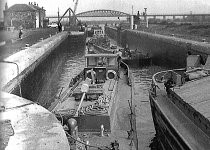
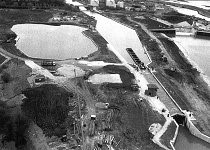
A 1699 Act of Parliament allowed the navigation to be constructed. The Aire was to be improved upwards from Weeland with the river below remaining in its natural state. Shallow water and sandbanks on this stretch became a problem and canals, first to Selby and then to Goole were built to bypass it. Unlike previous navigations, the backing was from merchants rather than landowners. This increasing importance of trade and industry was an early step in the start of the Industrial Revolution.
Just upstream of Castleford, a large opencast coalmine was opened near to the navigation. However it was built too close, the banks gave way, and for four days the Aire ran upstream from Castleford into the hole. The canal and river had to be moved westwards to avoid the lake.


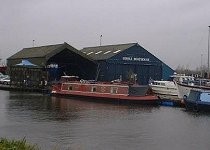
The company was nationalised in 1948, becoming part of British Waterways in 1973. In the 1970s, locks were lengthened to the 700-ton standard and new cargo handling facilities were built at Knostrop near Leeds. The canal managed to stay competitive with the railways of the late 19th Century and still continues to carry a large amount of cargo today.
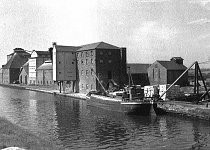
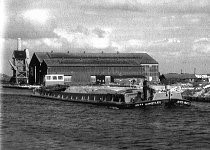

The canal is becoming increasingly important for its leisure use and better facilities, landscaping and water quality has attracted pleasure boating, towpath walking and fishing. Waterside museums, wildlife reserves pubs and restaurants are also adding to the tourist appeal.
Postcards
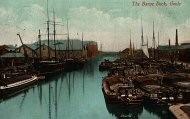
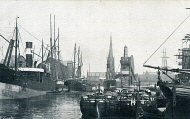

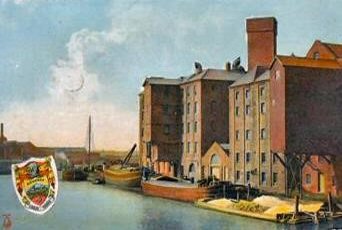
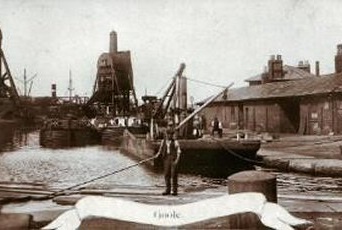

Visitor Comments
Posted by Pamela on 07/08/2005
I was told that my great-grandmother and her two children were drowned in Goole Docks after leaving their barge to go ashore. Their names were Harriet Ann Whiteley (28), son Ambrose (8) and daughter Annie (4). They were interred in Goole cemetery on 17 Dec 1871.
Can anyone help to find out more details? Thanks.
Posted by Rachael on 15/02/2006
I am trying to find information on the ELLEN AND JOSEPH a barge owned by my great-great-grandfather William Shaw that he carried flour on between Goole and Leeds. It was sold after his death in 1918.
Posted by Joy on 04/03/2006
Any trace of barging company owned by James William Calvert?
Posted by George on 25/03/2006
I wonder if you are related to the shipping company Alfred Calvert which was quite a big Goole shipowner mainly in the 1920s. They bought and sold a lot of second-hand (one careful owner!) steamers, I have a fleet list.
Posted by Joy on 23/07/2006
No, it has to be James William Calvert born 1879. I believe the firm was owner or agent for barge operations.
Posted by Roger on 17/09/2006
I'm one of Alfred Calvert's great-grandsons and have some details of the workings of the shipyard.
Posted by George on 05/10/2006
Were Calverts involved with the Ouse SB Co at Hook (approx. 1918-1923)? I think they later used the jetty there for repairs but am not sure who actually owned the short-lived shipyard which was an emergency yard set up in WWI.
Posted by Helen on 08/03/2007
I am trying to find out as much info on the Grindell's of Knottingley. John Grindell (b. 1794), was my great(x3)-grandfather and was a ship owner and master mariner. John Blackburn from Knottingley, also a ship owner and mariner, married John's daughter. John owned or part owned the BENJAMIN AND MICHAEL, SPRING RICE, JOHN AND ELIZABETH and ECLIPSE to name a few. I also have connections with Goole as my grandma was a Richardson; she was born at Goole Docks where my great-grandad owned a barge. I'm interested in any Pattisons and Horsteads that may have had vessels at Goole too. Plus, could anybody suggest any useful sites for researching this subject? I am wanting to know what life was like living on the boats with families, the conditions, etc. Thanks.
Posted by Centini Productions on 04/06/2007
Locks & Quays (Series 3) is currently in pre-production and due to begin filming this summer. In this series we will be making the journey coast to coast from Hull to Liverpool. The ten episode journey, due to be shown on ITV1 in the Granada and Yorkshire regions, will take viewers along the Aire & Calder Navigation and join the Leeds & Liverpool Canal to its end in Liverpool. The series will celebrate the canal communities, the holiday makers and the people who make their living afloat along this stunning stretch of the British Waterways. We will embrace the local heritage and history along the route and the spectacular countryside and signs of urban renewal as we travel through the villages, towns and cities built around the canals.
We want to hear from the people who live, work or holiday on these canals and those who enjoy the canals from the towpath.
Posted by Robert on 21/01/2008
The first programme in Granada's Series Three of Locks and Quays has six or seven minutes about Goole, about 9 minutes in from the start, although Goole gets mentioned a number of times before this, and the whole thing is worth a view. "Matthew Corbett's journey along the River Humber and into the integral port town of Goole, culminates with Matthew heading back out on to the start of the Aire & Calder Navigation as he completes the first leg of his epic 197½ mile long voyage." My only disappointment was that Matthew's furry yellow friend is no longer with him.
Posted by Les on 02/06/2008
As a commercial boat enthusiast, I reckon Matthew's furry friend might have done a better job. They must have done a lot of research to make sure they missed what commercial traffic there still is on the canal. Places like Harkers Yard should have got a mention.
Posted by Shuffleton Streets on 06/06/2007
Info sought on The Cooperage, once sited where Goole Boat House is. There was a works and at least one dwelling house, occupied in 1891.
Info also appreciated on other dwelling houses and farm cottages too - along the railway and the canal, and the Dutch River Side - between Rawcliffe and Goole. Many shown on early census data - some occupied by farm workers, others by railway employees, and presumably canal lock-keepers. Anything that anyone knows about this particular stretch with names and dates if possible. Thanks
Posted by Pedro on 16/06/2007
The Cooperage, later Smiths Boatyard, currently The Boat House. I remember Smiths yard moving but believe by this time Aire & Calder were involved in the business. Eric Hepponstall living at Airmyn was running the show. Eric served his time as a fitter at Goole Shipyard.
Posted by Robert on 19/06/2007
In the 1930s a couple called Watson and Sophia Tasker lived in one of the canal cottages near the engine sheds on the Airmyn side.
Posted by Shuffleton Streets on 19/06/2007
Thanks owed to Robert for his very detailed background post-1901 to what was simply a name on my lists from the Goole Times Almanacks. Keep it coming - there's a whole world in that small area that is Oakhill, Engine Sheds, Sidings and Canal-side. Made my day.
Posted by Pedro on 09/07/2007
Can't help with any info about the Cooperage yet. I hope to jog my elder brother's memory – he's in his late 80s. But a cooperage certainly would make sense in the area. Barrel making - look at the clues: seasoned timber on the mill pond, maltkins, flourmillers, breweries, etc. All products transported and packed in barrels possibly by canal barges or ships.
Posted by Shuffleton Streets on 16/07/2007
Thanks for all cooperage info. There is also a picture in the Waterways Museum of potatoes packed in barrels. And of course these were a staple crop in 1850s at the Airmyn farms. Plus the Bennett's ships built on potatoes grown in the Eastoft area and merchanted by J.B. Bennett. I found a guy living in Manuel Street 1901 census who was a working cooper too.
Posted by Corby on 28/11/2007
I had the pleasure of serving my apprenticeship as shipwright/boat builder 1949 – 1956 at Smith's boatyard and the timber pond; under Jack Smith, Walt Smith, Alf Smith and Thomas Greenfield Smith. George, son of Jack, being the engineer, Harold Lockwood (joiner). Norman (Slogger) Slieght (boatbuillder), Harry Fielder (boatbuilder)
Boat builder apprentices were Bernard Nichols, Rowland Palmer, Alan(?) and myself.
Posted by Chris on 11/11/2007
I have just discovered that one of my ancestors, Robert Cawson, aka Masters, was killed in December 1898, due to the collapse of a crane platform on the Goole Canal. If anyone has any information about this, I would be very grateful to hear from them. Thanks.
Posted by Tricia on 23/11/2007
I would love to know more about life as a mariner and canal boatman. A branch of my family lived on the water and several were mariners.
Posted by Pedro on 23/11/2007
I had five uncles all ex-mariners then canal and river boatmen (bargees). I myself went to sea at fifteen years of age. On one occasion the ship I was on came into Hull from West Africa with a cargo of cocoa and coffee beans. The barges loaded from our ship into my uncles' barges; these in turn went up river to York (Rowntrees factory). During the early-1950s the river Ouse was a hive of activity; a tug would sometimes tow as many as eight or more barges up river to various ports. The other canal transport would enter Goole locks and proceed along the canal to Leeds/Sheffield/Knottingley/etc.
Some of the local barge companies in my youth were Woods of York, G.D. Holmes (Goole), Bleasedales (Goole), Harkers (Knottingley), Eastwood (Goole). There were numerous privately owned vessels with the family on board; some were indeed born on the vessels (a sort of water Gypsy). In later years for various reasons (schooling, etc.) many took up residence in the Richard Cooper/Phoenix Street area.
Posted by Willo on 04/12/2007
Saw the mention of the Eastwood family as barge owners. They are part of my family and came from Barmby. They had been associated with barges on the Ouse since the early 19th Century. My grandfather was Joseph William and named a barge JWE after himself, which my uncle Alan owned until the work died in the early 1970s. Another uncle Tommy owned the BRILLIANT STAR an original Billy Boy, she's now moored in Wakefield and pretty much in bad shape. She was built in the late 1890s. Another uncle Joe worked for G.D. Holmes and later on all the brothers were pilots from Goole up river to Selby. Two of Joe's sons who still live in Goole also worked on the river and later became pilots as well.
Posted by Gail on 10/05/2008
I'm researching the LYALLs?/RYALLs (and other various spellings) family who lived on barges and worked the canals from Knottingley to Goole. Their barges were built in Thorne, they had GEORGE AND MARY, FOUR BROTHERS, THREE SISTERS, and GEORGE AND ANN, which was one of the first iron barges to be built (I have a photo of this one at its launch). If anyone is researching the same family, or can give me some idea of how they lived on the barges, I'd be very grateful!
Posted by Stella on 21/02/2010
My great-grandmother was Mary Jane Lyall (or Ryall). My grandfather Henry Ives was on the barges, and they lived in Blast Lane Sheffield for many years.
Posted by Rachel on 31/03/2010
I found this by chance. I know nothing about barges (although I'll be looking into that now) but am researching the Lyall family in Sheffield. My lot were around the Park area of Sheffield.
Posted by Gail on 23/03/2014
George Lyalls married Ann Dukes and they owned several barges including the "George and Ann", which was an iron barge, built in Thorne. I have a photo of the boat with family members on board, along with, I think, the people who made it.
Posted by Suz on 21/06/2014
I am very interested in Gail's message as my family had the barge "George and Ann" in 1861. John and Hannah Naylor later had the ELIZABETH.
Posted by Pam on 14/01/2011
I am also researching the Lyall family as Mary Jane Lyall, who married Henry Ives, was my great-grandmother
Posted by John on 28/08/2008
I used to dive off Tom Puddings into the canal as a kid - very dangerous as I know now, but not a thought then in the 1960s. The canal had two levels; one half was about three foot deep the other half was real deep. I remember trying to swim to the bottom.
My friend's dad was canal keeper, his name was Dixon; he lived at the side of canal in a deep ravine which once flooded. We also used to dive off the rail bridge that runs over canal too, near to where the museum is - those were the days.
Posted by Anna on 13/12/2011
The friend of yours that dived off the railway bridge, did I know him? My father was William Henry Dixon. He was a top darts player and so was my mother Ethel. I came to Goole at the age of three on a narrow boat called TIPTON. It had a petrol/diesel engine in it. We came from Birkwood on that narrow boat with all our animals like goats, hens, ducks, pigs and a cat called Blacky and a dog called Lassie.
They both loved to swim in the canal. I went to school in Old Goole at the age of five. I can still remember the day we landed in Goole or should I say Airmyn as No. 5 Swing Bridge was in the borough of Airmyn, not Goole. It was right next to the BR engine shed - yes, I had my own railway to myself.
Thank you BR, you could set your watch by the coal trains, like WD 2-8-0 Austerity locos numbers 90531, 90300, 90213, 90228, 90186, 90281. All 25C shed code of Goole: 90099, 90132, 90172, 90094, 90091, 90009. I remember the shunters where 0-6-0 tender locos and some tank locos, mostly Aspinalls class 23s and class 27s. With L&YR the smallest ones we had at Goole were the unforgettable 0-4-0 L&YR Aspinall Pugs like 51222 (three little ducks – that's what we all called it!) and numbers 51241 and 51244. I can go on for ever with steam locos!
Posted by John on 10/09/2008
Harry Dixon and his family lived in a cottage near the museum on Dutch Riverside where the road ends. He lived there in 1970s. He used to look after canal. He was a fine gentleman too. Old Harry we called him.
Posted by Anna on 24/02/2013
William Henry Dixon, known as Harry Dixon, was my father. We lived at No. 5 Swing Bridge and later Orchard Cottage near No. 1 Drain, Airmyn District. Lots of people think it's part of Old Goole but it's not – it's Airmyn District Council. To vote, we had to go all the way to Airmyn over three miles away. To get to school we had a 2½ mile walk, no buses could get up that narrow road. It took the farmer all his time to get his tractor up the lane. You could set your watch or clock by the WD 2-8-0 (90000) Class Steam Locomotive. They pulled 60 x 16 ton coal wagons out of Goole marshalling yard
A funny thing was two barges getting stuck in No. 5 Bridge hole. The skippers were too busy watching my mother putting the washing out on the washing line. It took four hours to get them free. There was a big argument to whose fault it was. Happy days.
Posted by Barrie on 01/03/2013
Exactly where was No. 5 Swing Bridge and was there a house next to the bridge or was that for the bridge keeper?
Posted by Anna on 12/03/2013
No. 5 Swing Bridge, Airmyn, on the Aire & Calder Canal. The house was located at the side just back from the swing bridge way. It was abandoned because of flooding in the cellar. We were the last to live in this house. It was a shame to see it pulled down, as inside it was real special with tongue and grooved polished ceiling and floors. There was no plaster ceiling anywhere in the house, it was all tongue and groove. Boards all varnished and polished so you could see yourself in the shine. There was a big Doncaster stove built in the chimney breast and there was the oven on the left hand side, the boiler on the right hand side and a fire in the middle.
There was a big fire guard around it all and my father got up at 6am, made the fire and then left the front door open and our hens and cockerel got in and sat on the fire guard. Sometimes it was the pig that got in. He got under the big table we had in the middle on the front room. He would then carry it on his back round the room trying to get it off. I could write a book of our young lives living there. Happy days, never to come back. We were very happy living in this nice house. I not seen a house like it since.
Posted by Barrie on 18/03/2013
Did you walk across the two wooden bridges across the railway at Oakhill Junction and up the lane towards the main road? I was friendly with the signalman at Oakhill Junction and cycled up that road many times around 1953 as a 14-year-old schoolboy. I remember the signalman told me that the railway wanted rid of the bridges but they were used regularly by someone who lived in a house near to the canal.
Posted by Anna on 11/09/2013
Yes we did cross the wooden bridges up near Rawcliffe signal box and I knew the signalmen, loco drivers and firemen too. I remember the steam locos running on all the lines around there and the one that went to Selby too. We went on the last push and pull train from Goole to Selby in the steam days. I remember the round house at Selby too and the one at Goole. It was my playground and very happy days we had back then. You can bring back steam for me any day. We loved the steam locos, even if they were black mucky things.
Posted by Bill on 17/02/2014
I remember going down to your mum and dad's house as a nipper and what a place it was. It's a shame it's no longer there. It would have made a great place for folk to visit to see how they lived in those days.
Posted by Helen on 26/11/2008
I'm researching the ASHBURN family into which my great-great-aunt married. They came from Doncaster but between 1851 and 1901 worked between Hull, Mexborough and Newark via Goole and all points between such as Keadby and West Stockwith. As other family members were coal merchants and lightermen, I suspect they were mainly in the coal trade. The Ashburns also married into the Batty family of Doncaster who were mainly boat haulers by trade. Two of their boats were the ZULU and the SLY FOX. Does anyone have any pictures or more info besides the censuses?
Posted by Tracey on 31/07/2015
I don't know if we are related. I am also related to the batty family from Doncaster who were up and down on the barges. Elizabeth and Beatrice I think were the names. Stephen Batty and Andrew Batty were my great-great-grandfathers.
Posted by Christine on 03/05/2016
I too, am researching Ashburns and found your post by putting "Sly Fox" into Google! My mother was an Ashburn. Her father, John Clifford Ashburn was descended from Ashburns who were lightermen in Hull in the later part of the 19th Century and before that on the canals. I know little about them other than Sly Fox is part of our family mythology. I'm afraid I have no photos, but your post has galvanised my research.
Posted by Glynne on 10/12/2008
Does anyone remember Harker's barge the MARGERY H? In the 1950s it was often moored in Barge Dock near Laing's sugar refinery. It had a brass plate on its stern rail saying that it had taken part in the Dunkirk evacuation, found at the end of the war in a damaged condition, repaired and restored to its owners. Often wondered what happened to it, or if it was scrapped, was the brass plate saved? I've inquired at the Waterways Museum and they knew nothing of it.
Posted by Techno Brit on 19/10/2010
My grandparents moved to Goole in about 1910. At the 1911 census, they were living in George Street. My last uncle was born in George Street in 1918. However, one uncle died in 1913 at "19, Barge Dock Side" and another was born at that same address, two months later.
My question is, what was at No. 19, Barge Dock Side? Was it a hospital or similar institution? All help much appreciated. Thanks.
Posted by Pedro on 25/11/2010
I don't think there was any institution or such around Barge Dock. However numerous residential properties existed in the area possibly No. 19 was one.
Posted by Techno Brit on 25/11/2010
Thanks for that, Pedro! I took a look at the 1911 Census, it looks a pretty built-up neighbourhood…
Posted by Hamish on 10/10/2011
Any chance there might be knowledge of the boat builders "Smiths" of Goole. I have recently undertaken the renovation of a 32ft 8 ton cabin cruiser called the OPINIO (whether the original name I do not know) which was in very poor condition and sunk for 18 months. I do not know what year she was built or any subsequent history apart from turning up in Shoreham by Sea around 2008 where she was abandoned. Any information gratefully received.
Posted by Corby on 08/11/2011
I served my apprenticeship for Smith Bros 1949-1955 and have knowledge of many of the boats built in the latter years. I have had a word with the boss's son who cannot recognise the name Opinio. He suggests you take note of her registration number which can be found on the main beam. Let us know this and it may help solve the mystery.
Posted by Corby on 23/11/2011
My findings are that Opinio was built in 1963, which was long after my time in Goole. The original owner was Charles Douglas Bramall of Bamford, Derbyshire.
Posted by Dave on 24/11/2011
My father used to own Opinio in the 1970s, lovely 20ft deck and a Parson's barracuda engine. We bought the boat from marine auctions in Christchurch, Dorset and I have many different memories of her. I think she was based on a Scottish fishing boat hull and was Lloyds registered, rolled like a pig?
Posted by Corby on 24/11/2011
So Hamish, there we have two owners already. But these boats were built to withstand North Sea conditions, so I shouldn't think that there will be a problem where you live.
Posted by Mike on 09/04/2013
The Opinio was owned by my stepfather from about 1990 to 1993. If you email me the boat's number I can confirm or otherwise if it's the same Opinio.
Posted by Ken on 04/06/2014
I am interested in finding out if anyone knows of pictures of the barges THETA, BETA, GAMMA, DELTA used to run from Hull to Leeds/Trent? I wonder if any of them are still in the water somewhere?
Posted by Jill on 02/01/2015
The farm I grew up on in Rawcliffe was owned by the Aire & Calder Navigation Co. in 1910. Could anyone help with any more information please? Thanks.
Posted by Anna on 15/06/2015
I worked for Wilfred Acaster on the RADIUS, DUMBUCK and STAINCLIFFE, sometimes the EASDALE or KIRKBY and the DELIVERY too. I remember most of the Humber barges running from Whitiker oil tankers to Cory tanks and Harkers tanks and Esso tanks. I can name them all and BWB barges too and most others. Old Wilf was one of a kind of old school bargemen. He worked barges all his working life and a good man to work for too. He would always see you right. He is much missed by me anyway and the barges too. Happy days we had but hard days too.
Posted by Karlie on 13/07/2015
Wilf was my great-grandad. My dad Karl he now runs Acasters Water Transport. They still have the barges and tugs.
Posted by Fred on 09/12/2020
I would love to hear from anyone who worked and sailed on barges in the 1950s and 1960s with Bleasdales of Hull to mainly Sheffield. I did, and was at that time known to be the youngest skipper on the Humber at 17. My main keel that I worked on was SHIRECLIFF. I left the company and worked on Tollman, United Deap Sea Tugs, then the army, and so on and so on, living in different countries. I am now 87, and just returned to England and I have so many good memories of my time on the barges, and would love to hear from anyone who can remember these times.
Back to Table of Contents
feedback@goole-on-the-web.org.uk